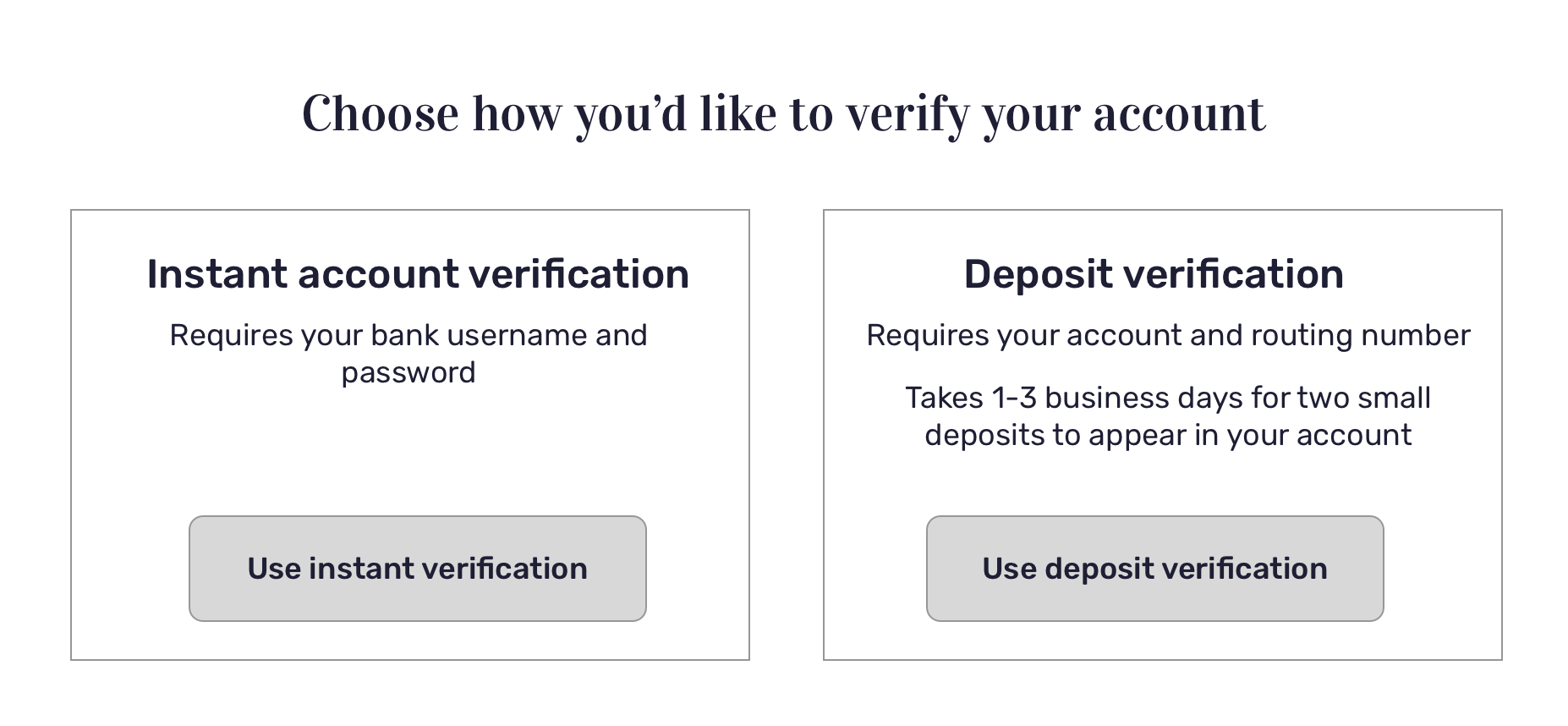For as long as most consumers (and bankers for that matter) can remember, financial institutions have been using micro deposits to validate ownership of linked accounts — but they have some major flaws.
Micro deposits are two small test deposits sent from one bank to another with the goal of verifying the second account information and ownership. Most bank customers will be familiar with the following user experience:



This process can take up to 5 business days to clear through the ACH Network until the account information can be validated. In a world where consumers expect instant value from online services, 5 days feels like an eternity.
Why do we use micro deposits for online account verification?
For decades banking infrastructure and software has been built around micro deposits as the exclusive form of external account validation.
In 2018, the National Automated Clearing House Association (NACHA) managed 23B micro deposit transactions with a total value of $51.2T. With its volume-based cost-recovery pricing structure, the ACH Network represents a very cost-effective payment infrastructure but it has struggled with immediacy. Despite the introduction of same-day ACH services in 2015, adoption with respect to micro deposits remains relatively low. NACHA has commented about an API-based, real-time validation approach, but no significant progress has been made towards an industry-wide standard in the United States.
Similarly, the majority of mobile and online banking suites available to banks and credit unions are focused on micro deposit methodology. Whether it’s custom built solutions from large banks to the ready-made products available from FIS or Fiserv, micro deposits represent the exclusive form of external account validation.
Why you shouldn’t use micro deposits
Banks and credit unions can learn a lot from modern e-commerce companies. Customer experience in the web 2.0 era is defined by immediacy. Customers are not willing to wait for basic services, particularly where there is an abundance of substitute goods and services. A delay in purchase completion is directly correlated to cart abandonment.
In the banking context for example, every additional 10 seconds added to an application process directly correlates to a 5% increase in application abandonment.
Therefore, one of the simplest strategies to increase your conversion rates and improve customer acquisition economics is to optimize your application process for speed and automation. When conversion funnel improvements are measured in seconds, the concept of a 3-5 day delay is a non-starter.
Best practices for bank account verification
Financial institutions want to validate ownership and account information for third party accounts before remitting money. If micro deposits are widely used in the banking industry, but decrease the likelihood that customers get validated and finish the account opening process, what other options do we have to validate bank accounts?
There are two best practice replacements for micro deposits.
Instant account verification
It’s important to continue to lean on the customers to validate their relationships with other institutions, but in a more seamless and immediate fashion.
A market leading solution in the Instant Account Verification space is Plaid. Plaid allows customers to validate their external accounts by verifying their user credentials for those external mobile and online banking institutions, in a single sign-on connection. Following a successful “auth” of a user into their external bank, Plaid can return to MANTL the account and routing information to facilitate NACHA file creation. More importantly, this process takes seconds, and provides real-time account validation.
Real-time account transaction monitoring
Most banks have a bigger challenge switching off of micro deposits – they can’t access their own data.
Banks and credit unions have institutional data that, when used correctly, is predictive of funding fraud*. Often this data is trapped within an institution’s core banking system and/or is only available overnight on a batch basis, making real-time account verification impossible.
MANTL’s APIs allow for real-time consumption of core banking data, and when combined with 3rd party APIs – which provide queryable databases of negative news on US based account numbers – make real-time decisioning possible and highly effective. For example, the MANTL API has a real-time integration to Alloy’s transaction monitoring and decisioning system. Which allows for decisioning on a wide variety of funding transactions, including wire and ACH transfers. Deposit operations and risk management can construct, test, edit and run a variety of decision workflows.
With MANTL’s partnership with Alloy, external ACH transfers can be run through a decision matrix that calculates the transfer size and compares it against historical transfer sizes, the current account balance, risk scoring at account originated and over 50 other internal and external factors. Each workflow and decision matrix can be edited real-time and published via MANTL, allowing banks and credit unions to respond immediately to changing risk and fraud vectors.
Consumer trends require real-time account verification
Micro deposits had a time and place in the tool kit of financial institutions, but consumer expectations have changed and immediacy is critical to success in a digital environment. There are better alternatives to replace micro deposits for both financial institutions and customers.
With MANTL, it is possible for traditional banks and credit unions to quickly and efficiently replace micro deposit practices to increase conversion.
* In 2008, an enterprising college student, Michael Largent from Plumas Lake, California exploited a loophole in the micro deposit process to fleece E*Trade and Schwab for $50,000 over a 6-month period. His script opened 58,000 online brokerage accounts in the names of fictitious cartoon characters and linking them to online bank accounts. In the process he accumulated thousands of dollars… one or two cents at a time.
Michael was eventually caught by the US Secret Service, but not before he had accumulated 11,385 Schwab accounts operating under the name “Speed Apex” – all originating back to his home internet account. He was sentenced to 15 months in prison for computer fraud in September 2009.
Learn more about MANTL’s real-time account verification solution.











